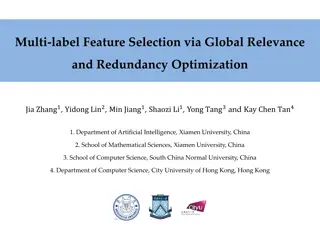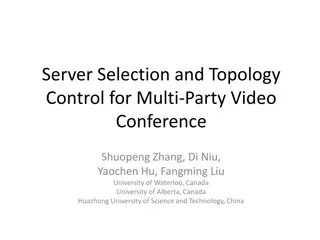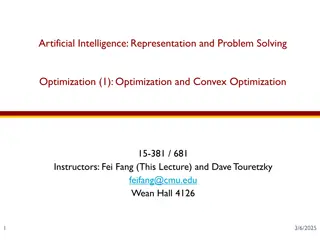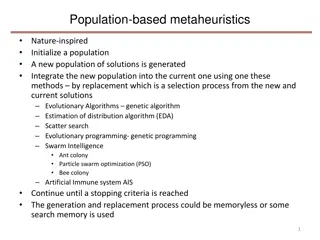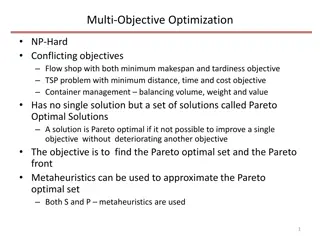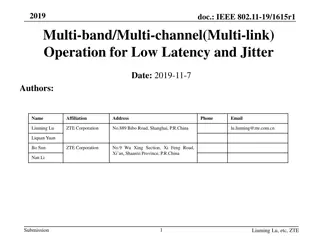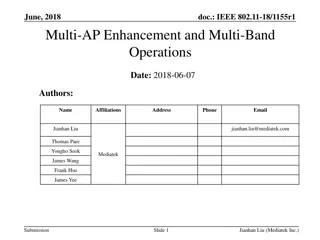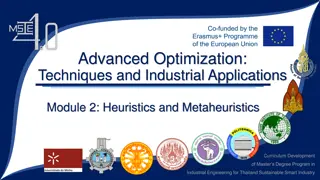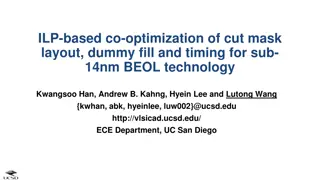Enhancing Query Optimization in Production: A Microsoft Journey
Explore Microsoft's innovative approach to query optimization in production environments, addressing challenges with general-purpose optimization and introducing specialized cloud-based optimizers. Learn about the implementation details, experiments conducted, and the solution proposed. Discover how
7 views • 27 slides
Swarm Intelligence: Concepts and Applications
Swarm Intelligence (SI) is an artificial intelligence technique inspired by collective behavior in nature, where decentralized agents interact to achieve goals. Swarms are loosely structured groups of interacting agents that exhibit collective behavior. Examples include ant colonies, flocking birds,
7 views • 88 slides
DNN Inference Optimization Challenge Overview
The DNN Inference Optimization Challenge, organized by Liya Yuan from ZTE, focuses on optimizing deep neural network (DNN) models for efficient inference on-device, at the edge, and in the cloud. The challenge addresses the need for high accuracy while minimizing data center consumption and inferenc
7 views • 13 slides
Discrete Optimization in Mathematical Modeling
Discrete Optimization is a field of applied mathematics that uses techniques from combinatorics, graph theory, linear programming, and algorithms to solve optimization problems over discrete structures. This involves creating mathematical models, defining objective functions, decision variables, and
4 views • 12 slides
Generalization of Empirical Risk Minimization in Stochastic Convex Optimization by Vitaly Feldman
This study delves into the generalization of Empirical Risk Minimization (ERM) in stochastic convex optimization, focusing on minimizing true objective functions while considering generalization errors. It explores the application of ERM in machine learning and statistics, particularly in supervised
6 views • 11 slides
Global Relevance and Redundancy Optimization in Multi-label Feature Selection
The study focuses on optimizing multi-label feature selection by balancing global relevance and redundancy factors, aiming to enhance the efficiency and accuracy of data analysis. It delves into the challenges posed by information theoretical-based methods and offers insights on overcoming limitatio
2 views • 15 slides
Insights into Recent Progress on Sampling Problems in Convex Optimization
Recent research highlights advancements in solving sampling problems in convex optimization, exemplified by works by Yin Tat Lee and Santosh Vempala. The complexity of convex problems, such as the Minimum Cost Flow Problem and Submodular Minimization, are being unraveled through innovative formulas
9 views • 47 slides
Performance Aspects of Multi-link Operations in IEEE 802.11-19/1291r0
This document explores the performance aspects, benefits, and assumptions of multi-link operations in IEEE 802.11-19/1291r0. It discusses the motivation for multi-link operation in new wireless devices, potential throughput gains, classification of multi-link capabilities, and operation modes. The s
5 views • 30 slides
Approximation Algorithms for Stochastic Optimization: An Overview
This piece discusses approximation algorithms for stochastic optimization problems, focusing on modeling uncertainty in inputs, adapting to stochastic predictions, and exploring different optimization themes. It covers topics such as weakening the adversary in online stochastic optimization, two-sta
3 views • 33 slides
Multi-Stage, Multi-Resolution Beamforming Training for IEEE 802.11ay
In September 2016, a proposal was introduced to enhance the beamforming training procedures in IEEE 802.11ay for increased efficiency and MIMO support. The proposal suggests a multi-stage, multi-resolution beamforming training framework to improve efficiency in scenarios with high-resolution beams a
5 views • 11 slides
Optimizing Multi-Party Video Conferencing through Server Selection and Topology Control
This paper proposes innovative methods for multi-server placement and topology control in multi-party video conferences. It introduces a three-step procedure to minimize end-to-end delays between client pairs using D-Grouping and convex optimization. The study demonstrates how combining D-Grouping,
3 views • 13 slides
Flower Pollination Algorithm: Nature-Inspired Optimization
Real-world design problems often require multi-objective optimization, and the Flower Pollination Algorithm (FPA) developed by Xin-She Yang in 2012 mimics the pollination process of flowering plants to efficiently solve such optimization tasks. FPA has shown promising results in extending to multi-o
2 views • 15 slides
Overview of DICOM WG21 Multi-Energy Imaging Supplement
The DICOM WG21 Multi-Energy Imaging Supplement aims to address the challenges and opportunities in multi-energy imaging technologies, providing a comprehensive overview of imaging techniques, use cases, objectives, and potential clinical applications. The supplement discusses the definition of multi
3 views • 33 slides
Machine Learning Applications for EBIS Beam Intensity and RHIC Luminosity Maximization
This presentation discusses the application of machine learning for optimizing EBIS beam intensity and RHIC luminosity. It covers topics such as motivation, EBIS beam intensity optimization, luminosity optimization, and outlines the plan and summary of the project. Collaborators from MSU, LBNL, and
5 views • 23 slides
AI/ML Integration in IEEE 802.11 WLAN: Enhancements & Optimization
Discussing the connection between Artificial Intelligence (AI)/Machine Learning (ML) and Wireless LAN networks, this document explores how AI/ML can improve IEEE 802.11 features, enhance Wi-Fi performance through optimized data sharing, and enable network slicing for diverse application requirements
4 views • 11 slides
Fast Bayesian Optimization for Machine Learning Hyperparameters on Large Datasets
Fast Bayesian Optimization optimizes hyperparameters for machine learning on large datasets efficiently. It involves black-box optimization using Gaussian Processes and acquisition functions. Regular Bayesian Optimization faces challenges with large datasets, but FABOLAS introduces an innovative app
5 views • 12 slides
Key Principles of Multi-Echelon Optimization (MEO)
Multi-Echelon Optimization (MEO) aims to maximize service returns from inventory investments by determining optimal stocking levels and creating robust stocking plans. It incorporates business rules and practical constraints while building realistic supply chain models to minimize discrepancies betw
1 views • 8 slides
Machine learning optimization
Dive into the world of machine learning optimization with a focus on gradient descent, mathematical programming, and constrained optimization. Explore how to minimize functions using gradient descent and Lagrange multipliers, as well as the motivation behind direct optimization methods. Discover the
3 views • 16 slides
Artificial Intelligence: Representation and Problem Solving Optimization
This lecture explores optimization and convex optimization in the field of Artificial Intelligence, covering topics such as defining optimization problems, discrete and continuous variables, feasibility, and different types of optimization objectives. The content delves into the challenges and solut
1 views • 36 slides
Optimization Techniques for System Design
Introduction to optimization in system design, focusing on maximizing or minimizing objective functions. Explore types of optimization - unconstrained and constrained, with practical examples. Learn about computational methods for solving optimization problems and discover the implementation of opti
0 views • 12 slides
Practical Challenges in Portfolio Optimization
This paper delves into the practical challenges and current trends in portfolio optimization, discussing aspects related to using portfolio optimization in practice and highlighting new methods and developments. The content covers a brief introduction, Mean-Variance Optimization (MVO), extensions of
20 views • 18 slides
Equality Constrained Optimization Overview
This content delves into Chapter 10 of convex optimization covering equality constrained optimization. It explores various formulations, eliminating equality constraints, dual formulation, KKT conditions, and optimization methods like Newton's method. The formulation examples and theoretical concept
3 views • 23 slides
Nature-Inspired Population-Based Metaheuristics and Optimization Techniques
This comprehensive guide delves into various population-based metaheuristics and nature-inspired optimization techniques such as evolutionary algorithms, swarm intelligence, and artificial immune systems. It covers concepts like genetic algorithms, ant colony optimization, particle swarm optimizatio
5 views • 6 slides
Metaheuristics for Multi-Objective Optimization and Hybrid Approaches
Discover the world of multi-objective optimization with NP-hard conflicting objectives, Pareto optimal solutions, and metaheuristics. Learn about fitness assignment, diversity preservation, and dominance-based strategies for finding Pareto optimal sets. Explore hybrid metaheuristics combining variou
0 views • 8 slides
IEEE 802.11-19/1615r1 Multi-band Multi-link Operation for Low Latency
Explore the proposal for multi-band/multi-channel operation in IEEE 802.11-19/1615r1 to enhance worst-case latency and jitter performance for real-time data transmission. The document discusses the benefits of multi-link aggregation, requirements for optimization, and channel access methods for impr
2 views • 10 slides
Multi-Band Multi-Channel Concept in IEEE 802.11be
Explore the benefits and models of Multi-Band Multi-Channel (MBMC) operation in IEEE 802.11be, including efficient spectrum use, increased data rates, and dynamic band switching. Learn about single band vs. multi-band operation and different deployment scenarios for APs and non-AP STAs. Discover the
4 views • 20 slides
Discrete Optimization in Graph Theory
Explore the relationship between counting techniques, graph theory, and discrete optimization, with examples illustrating the transition from counting problems to optimization problems. Learn about applying optimization in scheduling and making graph models, as well as the role of graphs in discrete
3 views • 8 slides
IEEE 802.11-18/1155r1 Multi-AP and Multi-Band Operations Overview
Explore the advancements in IEEE 802.11-18/1155r1 focusing on Multi-AP enhancements for enhanced coverage and throughput. Learn about cooperative multi-band operations and future possibilities for Wi-Fi networks. Discover the potential for joint multi-AP transmissions and the optimization of MAC and
1 views • 9 slides
Mastering Multi-Objective Optimization Techniques for Industrial Engineering
Explore the world of multi-objective optimization in industrial engineering through heuristic and metaheuristic approaches. Learn about aggregated weighted sum methods, Pareto optimization, and popular algorithms like MOGA and NSGA-II. Discover how to find trade-offs efficiently in smart industry ap
0 views • 9 slides
Cut Mask Co-Optimization for Advanced BEOL Technology
Explore the ILP-based co-optimization of cut mask layout, dummy fill, and timing for sub-14nm BEOL technology. The proposed approach addresses self-aligned multiple patterning, cut process extension, and the impact of cut mask optimization on wire performance. Learn about related works, motivation,
12 views • 23 slides
Optimization Fundamentals and Applications
Explore the essentials of optimization with this PowerPoint presentation by Peggy Batchelor from Furman University. Learn how to recognize decision-making scenarios suitable for optimization modeling, formulate algebraic and spreadsheet models for linear programming problems, and use Excel's Solver
1 views • 33 slides
Optimization of Digital Systems: Standard Forms and Multi-Level Techniques
Explore the fundamentals of digital systems optimization with standard forms and multi-level techniques. Learn about topics such as sum of products, product of sums, two-level circuit optimization, minterms, maxterms, functions of minterms and maxterms. Understand how to define optimal 2-level imple
2 views • 13 slides
IEEE 802.11-19/1583r0 Multi-Link BSS Operations Overview
Explore the major MLME functions for the Multi-Link model in the IEEE 802.11-19/1583r0 document, covering pre-association operations, authentication, association, and post-association power management. The submission delves into the overall architecture, phases in Multi-Link setup, and Multi-Link ca
0 views • 11 slides
Optimization of Media Criteria for Maximum Yield
The optimization of media before preparation is crucial for achieving maximum yield at an industrial level. Various criteria are considered for optimizing media to ensure efficient growth and production, such as maximizing yield, concentration, and rate of product formation while minimizing undesire
4 views • 17 slides
Quantum Adiabatic Optimization vs Quantum Monte Carlo: A Comparative Study
Explore the comparison between Quantum Adiabatic Optimization and Quantum Monte Carlo methods in optimization problems. Learn about the adiabatic algorithm, simulated annealing, possibilities for adiabatic optimization, and more. Discover the potential advantages and challenges in leveraging quantum
2 views • 19 slides
Problem Solving and Optimization in Artificial Intelligence
Explore the concepts of optimization and convex optimization in artificial intelligence, covering a variety of topics such as search, satisfiability, combinatorial and continuous optimization, and more. Delve into the definition of optimization problems, feasible regions, optimization objectives, an
1 views • 36 slides
Analysis of Algorithms for Multi-Objective Min-Max Optimization
Explore the comparison of two algorithms for multi-objective min-max optimization in the field of mechanical and aerospace engineering. The study delves into design under uncertainty, evidence theory, and methodology, providing insights into MACS and IDEA approaches. Learn about initialization techn
0 views • 26 slides
Optimization of Mapping and Scheduling for NoC-based MPSoCs
Explore the contention-aware mapping and scheduling optimization strategies for Network-on-Chip based Multi-Processor Systems-on-Chip at the Institute of Software, Chinese Academy of Sciences. The research addresses motivation, problem formulation, hybrid algorithm development, experimentation, and
0 views • 15 slides
Code Optimization Techniques
Explore the principles and methods of code optimization to enhance program performance. Learn about common subexpression elimination, loop transformations, and function-preserving optimizations. Understand the importance of safety and criteria for effective code optimization efforts. Dive into the w
1 views • 17 slides
Chemical Systems Multi-Objective Optimization
Focusing on the application of Machine Learning Directed Multi-Objective Optimization in mixed variable chemical systems, this research by Oliver Kershaw, Prof. Richard Bourne, and Dr. Nicholas Warren aims to autonomously optimize the manufacturing of APIs by simultaneously optimizing categorical an
2 views • 5 slides





